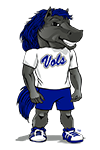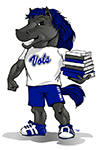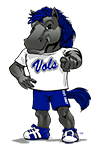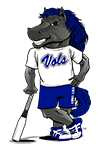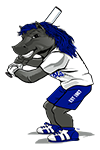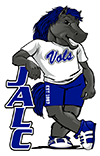John A. Logan College’s logos build a strong foundation for the college’s visual identity, which serves to build recognition for our institution across all audiences. As part of our Marketing and Public Relations branding initiatives, we strive to attain continuity with logos throughout the College.
John A. Logan College’s Department of Marketing, Public Relations, and Communications has created a style guide for our employees, vendors, and departments to use when using our branded elements. We encourage you to download it and read it as a primary source for all questions regarding our branding. If you have any additional questions not answered in the style guide, please get in touch with Dr. Steve O’Keefe, Assistant Vice President for Marketing, Public Relations, and Communications.
WHAT IS THIS STYLE GUIDE, AND WHY SHOULD I USE IT?
John A. Logan College’s brand and style is a collection of specifications that help you present our visual brand consistently to the world. It’s a road map to promote John A. Logan College externally and internally successfully. Our brand shows who we are as a college and the standard we hold ourselves. While a brand style guide is essential to building an effective marketing strategy, it also has a few more tangible use cases:
Gives our employees, contractors, and partners a central place to access necessary documentation and visual assets to create more compelling content
- It helps establish recognition and trust with our customers and audience.
- It helps maintain consistency, particularly when sharing marketing duties with third-party vendors.
- It lets us define what and who our brand is, not someone else.
Our Logo
Our institution seeks to remain true to our roots while staying visually relevant to the design trends of tomorrow. For this reason, we have begun using the Block Letter logo as the primary logo for the College, with the traditional Logan L and silhouette of John A. Logan as the secondary logo. Logan Athletics uses the script Vols as their primary logo. When placing the logo on a document, please always scale proportionally in vertical and horizontal height. Do not “squeeze” our logo to make it shorter or wider.
Downloadable files with transparent backgrounds.
Our Colors
Blue
HEX: #001489
PMS: 7687 C
CMYK: 100 86 15 03
RGB: 30 68 136
Our Typefaces
Headings Typeface: Oswald
Primary Typeface: Calibri (Body)
PowerPoint Template
Download PowerPoint template that can be used for presentations.
Press Releases
The Office of Marketing, Public Relations, and Communications must issue all official press releases. The College uses the Associated Press Style of Writing for official press releases.
A Quick Guide to the Associated Press Style of Writing
The Associated Press was founded in 1848 as a cooperative effort among six New York newspapers that wished to pool resources for gathering international news. Today, with over 3,700 employees in 121 countries, the AP is the world’s single largest news organization. More than a billion people read, hear, or see AP news daily. From the beginning, AP reporters have written their dispatches for readers from diverse social, economic, and educational backgrounds and a wide range of political views. The AP, therefore, strives to keep its writing style easy to read, concise, and free of bias. The Associated Press Stylebook, first published in 1977, clarified the news organization’s grammar, spelling, punctuation, and usage rules. Now in its sixth edition, the Stylebook is the standard style guide for most U.S. newspapers, magazines, and public relations firms. NUMBERS The following Quick Reference is taken from The Associated Press Stylebook and Libel Manual, Sixth Trade Edition. The following quick reference is taken from The Associated Press Stylebook and Libel Manual, Sixth Trade Edition.
NUMBERS
- Spell out the numbers one through nine; for 10 and up, use Arabic numerals.
- Spell out numerals that start a sentence; recast the sentence if the result is awkward: Twenty-seven detainees were released yesterday. Yesterday, 993 freshmen entered the college.
- The one exception to this rule is in a sentence that begins with a calendar year: 1938 was a turbulent year for Leon.
- Use Roman numerals for wars, monarchs, and Popes: World War II, King George VI, Pope John XXIII
- The figures 1, 2, 10, 101, and so on, and the corresponding words — one, two, ten, one hundred one, and so on — are called cardinal numbers. The terms 1st, 2nd, 10th, 101st, first, second, tenth, one hundred first, and so on are called ordinal numbers.
- For large numbers: use a hyphen to connect a word ending in y to another word: twenty-one, one hundred forty-three, seventy-six thousand five hundred eighty-seven
- Do not use commas between other separate words that are part of one number: one thousand one hundred fifty-five
- Spell out casual expressions: A thousand times no!
- Proper names: use words or numerals according to an organization’s practice: 3M, Twentieth Century Fund, Big Ten.
ABBREVIATIONS
United States
- as a noun, United States: The prime minister left for the United States yesterday.
- as an adjective, U.S. (no spaces): A U.S. soldier was killed in Baghdad yesterday.
- as part of organization names (see the AP Stylebook under “U.S.”)
States
- Spell out the names of the states in text when they appear alone: Wildfires continued to rage through southern California yesterday.
- Abbreviate them when they appear in conjunction with the name of a city, town, village, or military base: Needham, Mass., Oxnard Air Force Base, Calif.
- Do not abbreviate Alaska, Hawaii, Idaho, Iowa, Maine, Ohio, Texas and Utah
- (the two states that are not part of the contiguous United States and the states that are five letters or fewer) When abbreviating U.S. states, do so as follows: Ala. Ariz. Ark. Calif. Colo. Conn. Del. Fla. Ga. Ill. Ind. Kan. Ky. La. Md. Mass. Mich. Minn. Miss. Mo. Mont. Neb. Nev. N.H. N.J. N.M. N.Y. N.C. N.D. Okla. Ore. Pa. R.I. S.C. S.D. Tenn. Vt. Va. Wash. W.Va. Wis. Wyo.
Place one comma between the city and the state name and another after the state name, unless at the end of a sentence or in a dateline (e.g. She traveled from San Diego, Calif., to go to school in Kansas City, Mo. Now, she’s thinking of moving to Santa Fe, N.M.)
Datelines
- Put the city name in CAPITAL LETTERS, usually followed by the state, country, or territory where the city is located.
- Domestic and international large cities stand alone in datelines (see the AP Stylebook under “datelines” for a complete listing).
- Within stories: Follow the city name with further identification in most cases where it is not in the same state or nation as the dateline city.
Academic Degrees
- When stating academic degrees, avoid abbreviations: Billy Bob, who has a doctorate in philosophy.
- Use an apostrophe in bachelor’s degree, a master’s, etc.
- There is no apostrophe in Bachelor of Arts or Master of Science.
- Use abbreviations such as B.A., M.A., and Ph.D. only when the need to identify many people by degree on first reference would make the preferred method cumbersome; use the abbreviations only after a full name and set the abbreviations off with commas: Samuel Cotton, Ph.D., lectured yesterday on bioethics.
Dates
- Always use Arabic figures without st, nd, rd or th.
- Capitalize months.
- When a month is used with a specific date, abbreviate only Jan., Feb., Aug., Sept., Oct., Nov., and Dec. (e.g., Oct. 4 was the day of her birthday.)
- When a phrase lists only a month and year, do not separate the month and the year with commas. (e.g., February 1980 was his best month.)
- When a phrase refers to a month, day, and year, set off the year with commas. (e.g. Aug. 20, 1964, was the day they had all been waiting for.)
Time
- Use figures except for noon and midnight
- Use a colon to separate hours from minutes (e.g. 2:30 a.m.)
- 4 o’clock is acceptable, but time listings with a.m. or p.m. are preferred.
PUNCTUATION
Apostrophe (‘)
- For plural nouns ending in s, add only an apostrophe: the girls’ toys, states’ rights.
- For singular common nouns ending in s, add ‘s: the hostess’s invitation, the witness’s answer.
- For singular proper names ending in s, use only an apostrophe: Descartes’ theories, Kansas’ schools
- For singular proper names ending in s sounds such as x, ce, and z, use ‘s: Marx’s theories, the prince’s life.
- For plurals of a single letter, add ‘s: Mind your p’s and q’s. The Red Sox defeated the Oakland A’s.
- Do not use ‘s for plurals of numbers or multiple letter combinations: the 1980s, RBIs
Colon (:)
- Capitalize the first word after a colon only if it is a proper noun or the start of a complete sentence: He promised this: The company will make good all the losses. But There were three considerations: expense, time, and feasibility.
- Colons go outside quotation marks unless they are part of the quoted material.
Comma (,)
- Do not put a comma before the conjunction in a simple series: John, Paul, George, and Ringo; red, white, and blue.
- Use a comma to set off a person’s hometown and age: Jane Doe, Framingham, was absent. Joe Blow, 34, was arrested yesterday.
Dash (—)
- Make a dash by striking the hyphen key twice. Put a space on either side of the dash: Smith offered an unprecedented plan to raise revenues.
- Use a dash after a dateline: SOMERVILLE — The city is broke.
Hyphen (-)
- Use a hyphen for compound adjectives before the noun: well-known actor, full-time job, 20-year sentence
- Do not use a hyphen when the compound modifier occurs after the verb: The actor was well known. Her job became full time. He was sentenced to 20 years.
- Do not use a hyphen to denote an abrupt change in a sentence—use a dash.
Parentheses
- The perceived need for parentheses indicates that your sentence is becoming contorted. Try to rewrite the sentence, putting the incidental information in commas, dashes, or another sentence. If you do, use parentheses.
- If the material is inside a sentence, place the period outside the parentheses.
- If the parenthetical statement is a complete independent sentence, place the period inside the parentheses.
Period
- Use a single space after the period at the end of a sentence.
- Do not put a space between initials: C.S. Lewis; G.K. Chesterton.
Quotation Marks (“ ”)
- In dialogue, each person’s words are placed in a separate paragraph, with quotation marks at the beginning and end of each person’s speech.
- Periods and commas always go within quotation marks.
- Dashes, semicolons, question marks and exclamation points go within the quotation marks when they apply to the quoted material. They go outside when they apply to the whole sentence.
- Use single marks for quotes within quotes: She said, “He told me, ‘I love you.'”
TECH TERMS
Cyberspace, Email, Hyperlink, Internet, Login, Logon, Podcast, Shareware, Web page, Database, Facebook, Hypertext, iPhone, Logoff, Online, Twitter, Smartphone, Website
TITLES
Of books, computer games, movies, operas, plays, poems, songs, television programs, lectures, speeches and works of art:
- Put quotation marks around the title. • Capitalize the first and last words of the title.
- Capitalize the principal words, including all verbs and prepositions and conjunctions with more than three letters
- Translate a foreign title into English unless the American public knows the work by
Of newspapers and magazines:
- Do not place in quotation marks.
- Capitalize the in the name if that is the way the publication prefers to be known.
- Lowercase the before names if listing several publications, some of which use them as part of the name and some of which do not: Time, Newsweek, the Washington Post, and the New York Times.
- Where location is needed but not part of the official name, use parentheses: The Huntsville (Ala.) Times, The Toledo (Ohio) Blade.
Of places:
- The best reference for all place names is the “U.S. Postal Service Directory of Post Offices.”
- The best reference for foreign geographic names is the most recent edition of “Webster’s New World College Dictionary.” The second-best reference is the “National Geographic Atlas of the World.”
- Lowercase compass directions: The warm front is moving east.
- Capitalize names of U.S. regions: The Northeast depends on the Midwest for its food supply.
- The “Middle East” applies to Afghanistan, Cyprus, Egypt, Iran, Iraq, Israel, Kuwait, Jordan, Lebanon, Oman, Qatar, Saudi Arabia, South Yemen, Sudan, Syria, Turkey, United Arab Emirates and Yemen. The term is preferable to “Mideast.”
Of ethnic groups:
- The preferred usage for African Americans is “black.” The term is not capitalized.
- Preferred usage for Caucasians is “white,” also not capitalized.
- Preferred usage for Asian people is “Asian,” capitalized. Please note that in British usage, the term applies only to people of the Indian Subcontinent.
- “American Indian,” capitalized with no hyphen, is preferred over “Native American.”
Of seasons:
- Lowercase “spring,” “summer,” “fall” and “winter” and derivatives such as “wintertime” unless part of a formal name: I love Paris in the springtime; the Winter Olympics.



